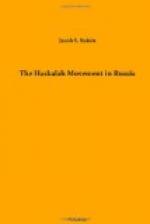The story of Maimon, as I have said, is the story of many of the peripatetic apostles of Haskalah, and his experience was more or less also theirs. Issachar Falkensohn Behr (or Baer Falkensohn, 1746-1796?), without funds, friends, or rudimentary knowledge of the subjects necessary for admission into a public school, left his native city of Zamosez with the determination to enter the university of “Little Berlin,” as Koenigsberg was called. Too poor to carry out his plan, he tramped to Berlin. Through the influence of his relatives and countrymen, Israel Moses Halevi and Daniel Jaffe, he was introduced to Mendelssohn, and was enabled to devote himself systematically to the study of German, the alphabet of which he had learned from Wolff’s treatise on mathematics, and to French, Latin, physics, philosophy, and medicine. In a very short time he mastered them all, especially German. His Gedichte eines polnischen Juden (Mitau and Leipsic, 1772) caused no little stir among the poets. Lessing and Goethe, close observers of symptoms of enlightenment among the Jews, expressed themselves differently as to the real merit of the collection; but both concurred with Boie, who, writing to Knebel, the friend of Goethe, remarked concerning them, “You are right; the Jewish nation promises much after it is once awakened."[29]
For one reason or another we find that some Slavonic Jewish youths preferred other places to Berlin for the pursuit of their studies. Such were Benjamin Wolf Guenzberg and Jacob Liboschuets. The former was probably the only Jew at the Goettingen University. It was from there that he inquired of Jacob Emden “whether it was permissible to dissect on the Sabbath,” and his thesis for the doctor’s degree was De medica ex Talmudicis illustrata (Goettingen, 1743).[30] Liboschuets studied at the University of Halle. After graduation, finding that as a Jew he could not settle in St. Petersburg, he established himself in Vilna, where he became celebrated as a diplomat, philanthropist, and, more especially, expert physician. When Professor Frank was asked who would take care of the public health in his absence, he is reported to have said, Deus et Judaeus, “God and the Jew” [Liboschuets]!
In their deep-rooted love for learning, they sometimes ventured even beyond the German boundaries, into countries whose language and customs had little in common with theirs. Padua continued to be the resort of Russo-Polish Jews that it had been before 1648. Moses Hayyim Luzzatto found an ardent admirer and zealous propagandist of his principles in the young medical student Jekuthiel Gordon (ab. 1729), who wrote concerning his master to friends in Vienna and Vilna.[31] Judah Halevi Hurwitz (d. 1797), whose work ’Ammude Bet Yehudah (Amsterdam, 1765) was highly recommended by Mendelssohn and Wessely, was a graduate of the same famous institution. In addition to his medical and philosophic attainments, he wrote a number of poems, and he was among the first to translate fables from German into Hebrew.[32]




